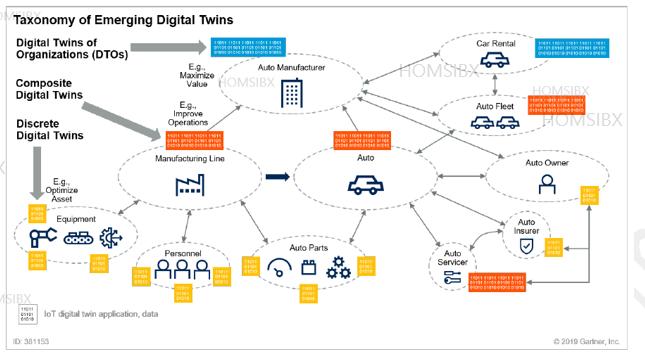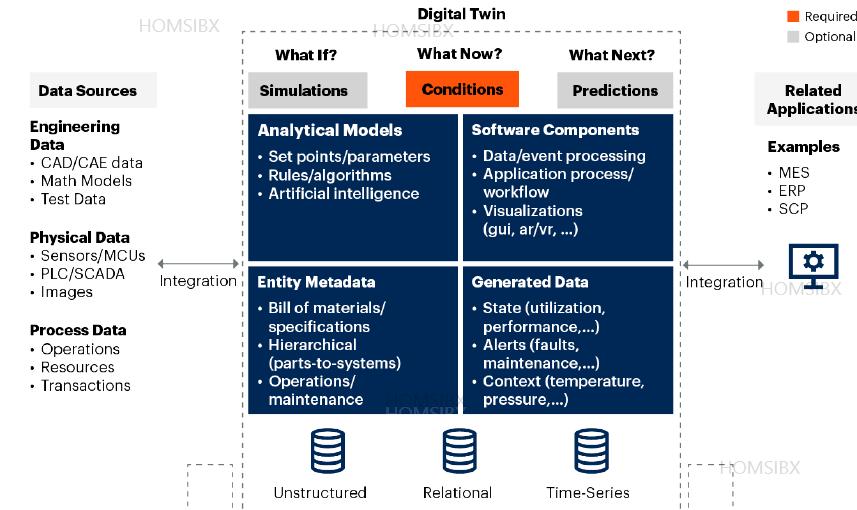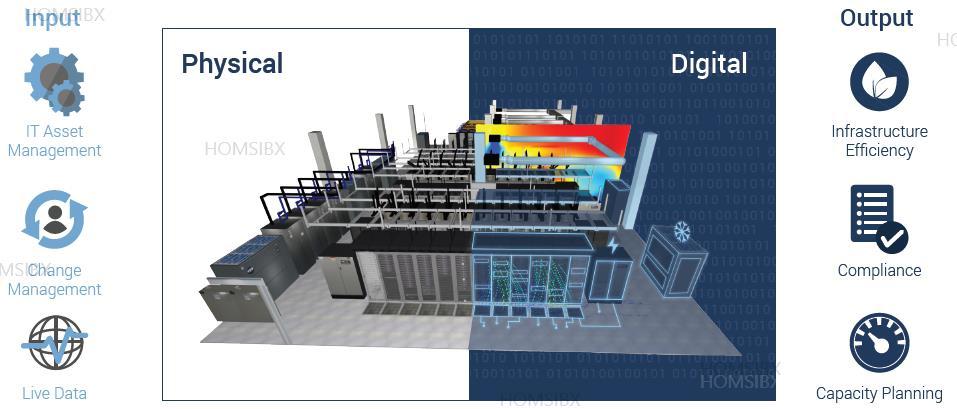ISSN 2348-1196 (print)
International Journal of Computer Science and Information Technology Research ISSN 2348-120X (online) Vol. 8, Issue 3, pp: (291-296), Month: July - September 2020, Available at: www.researchpublish.com

ISSN 2348-1196 (print)
International Journal of Computer Science and Information Technology Research ISSN 2348-120X (online) Vol. 8, Issue 3, pp: (291-296), Month: July - September 2020, Available at: www.researchpublish.com
Bilal Homsi1
1Dhahran, Saudi Arabia
Abstract: As part of the digital transformation drive across enterprise, fueled by Covid-19 pandemic, new technology trend is emerging in providing Digital Twin which is a digital replica of actual physical assets, processes, people, places, systems and devices that can be used for various purposes. This article will go over the digital twin technology, different types and reference architecture and will focus specifically on the digital twin for IT Data Center and its applicable use cases.
Keywords: Digital Twin, IoT, DTO, 3D, PLC, SCADA, UPS, BOM, CMDB, DCIM, CFD, CFM, PDU, RPP, BMS.
Digital twins are an emerging technology trend of enterprise software that generate insights about the state of things in order to produce informative insights and improved business outcomes. Widespread Internet of Things (IoT) adoption is driving increased deployment of digital twins to optimize enterprise-level business operations
Digital twin is a replica of the physical object in a digital format. Digital twins use sensors joined to physical objects to receive and broadcast data regarding those physical devices. The concept behind it is to build, test, and simulate equipment in a three-dimension (3D) virtual environment.
Fig 1: Taxonomy of Digital Twins (Courtesy of Gartner)

ISSN 2348-1196 (print)
International Journal of Computer Science and Information Technology Research ISSN 2348-120X (online) Vol. 8, Issue 3, pp: (291-296), Month: July - September 2020, Available at: www.researchpublish.com
This is lowest level of abstraction that is still sufficient to meet the requirements of a specific use case. It adds no value in breaking it down in components or parts. It is used to optimize individual assets, people, and other physical resources, e.g. individual asset optimization
It is a combination of discrete digital twins that represent an entity comprised of multiple individual components or part, e.g. optimizing assembly line
DTO are used to maximize value across industrial processes such as manufacturing, or across entire business operations, e.g. optimizing overall manufacturing capacity based on changing marketing strategy, or maximizing business value for the corporate.
Digital twins always monitor things, but digital twin data is often analyzed to predict future state, and at times is also used to simulate the behavior of physical things, processes or people. Regardless of the type of digital twin use case or whether a digital twin happens to be simple or complex, as illustrated in Figure 2, every digital twin design includes four basic building blocks:

It is about the information to describe the twinned object, including its physical components, how they are assembled, the object’s behavior and specifications, and so on (e.g. the composition and operation of a Chiller). The amount of metadata detail needed varies widely. For example, to support the optimization of maintenance and operations for a complex piece of equipment, the metadata will likely need to include a detailed physical model, bill of materials and specifications. On the other hand, for a simple connected device like a camera or bulb, the only metadata needed to help identify the source of data would be the location of the device, its model and serial number.
Top challenges in selection of the right entity metadata are:
A key challenge for digital twin designers is modeling sufficient few attributes of a twinned object. The key to success is by correctly anticipating what data is really needed for your decision making. Another challenge is to keep entity metadata up to date as changes to twinned objects occur. This can be addressed by timely synchronization of metadata
ISSN 2348-1196 (print)
International Journal of Computer Science and Information Technology Research ISSN 2348-120X (online) Vol. 8, Issue 3, pp: (291-296), Month: July - September 2020, Available at: www.researchpublish.com
with application data. To avoid data becoming obsolete, policies will be needed to ensure that digital twin metadata is updated when changes occur.
It covers IoT sensor-based time-series data, external contextual data, and whatever other data is used by analytical models (e.g., the chiller’s flow rate, temperature and power consumption).
A top challenge is collecting the minimum amount of viable data needed for monitoring and analysis to achieve desired outcomes. The issue is to avoid collecting too little data which creates gaps or errors in monitoring and analysis or too much data which can obfuscate whatever data matters, was network bandwidth or computing resources. Successfully collecting the right data is a technical and organizational challenge. It is a technical challenge because data can be processed, for example, either on the edge or in the cloud. Which approach you choose can impact computing and network. Also, existing commercial and industrial equipment may generate some of the required data, but you may also require specialized integration tools to access programmable logic controllers (PLCs), supervisory control and data acquisition (SCADA) systems and other controllers. And new sensor kits may need to be added to older equipment to fill data gaps.
It is about software algorithms that ingest generated data and produce events which increase situation awareness (e.g., UPS Battery will fail in 1 to 2 months). At best, analytical models are approximations of true behavior. The predictions and recommendation coming from these analytical models should be studied and considered. But, if they are to be acted on, they should be applied with a healthy skepticism that the decisions they suggest might, at times, be wrong. Evidence and logic should be established to build confidence that the output of the analytical model can be trusted for the decision being made. Contingencies should be planned and made available in case the outcome of analytical models is wrong. At their greatest value, they are a learning tool that can be successively refined over time with experience using them. Knowing that, the business response should take into consideration the confidence in the findings and response workflow, then be revised over time to address different situations. Rightsizing the model is critical. Making a highly detailed granular analytical model can be very expensive and time-consuming while adding too much detail can introduce significant errors. In contrast, creating overly simplistic analytical models will filter out important behaviors that also produce misguiding results.
It is about application logic, visualization tools and other functionality to act, based on events produced by analytical models (e.g., generate a “Fix-It” ticket for Chiller). A top key challenge is avoiding unnecessary digital twin vendor lock and technical obsolescence. This can be addressed by doing quick win digital twin design, then incrementally enhance. Another key challenge is to avoid creating monolithic digital twin software components. This can be remediated by rightsizing design by maintaining digital twin software components. Last, integrating digital twin events with key business application workflows might be an obstacle and this is addressed by keeping integration strategy and tools up to date to support digital twin integration
Digital Twin also has other dependencies to have a complete end-to-end working digital twin model consisting of the below three components:
Data Sources consists in any form of information used as input into a digital twin’s entity metadata or as input into a digital twin’s generated data. Data sources vary widely by use case. As illustrated in Figure 2, digital twins can be designed to use a mix of unstructured (e.g., PDF specification), relational (e.g., Bill-Of-Material (BOM) or time-series (e.g., IoT sensor) data. Data types and volume of data to use varies widely by IoT use case, so the variety and amount of data needed for a digital twin of a compressor is trivial compared to a complex manufacturing process. Regardless, when implemented in scale, managing large volumes of data creates many governance challenges, such as how to organize, secure and control access to data.
ISSN 2348-1196 (print)
International Journal of Computer Science and Information Technology Research ISSN 2348-120X (online) Vol. 8, Issue 3, pp: (291-296), Month: July - September 2020, Available at: www.researchpublish.com
Digital Twin Enabling Technology consists in application middleware used for digital twin software development and runtime (i.e., development tools, runtime platform). While most digital twins conform to set software design pattern that includes the four digital twin reference model building blocks listed above, the technologies used to implement digital twins vary widely.
Operational and Business applications that are integrated with digital twins (when needed) to make them act on events generated by digital twin analytics as Incident Management, ERP Systems, Configuration Management Database (CMDB), Asset Management… As illustrated in Figure 2, in its full realization, a digital twin should be integrated with one or more business applications to automate your business response to a generated event. Another aspect of digital twin is that different digital twins’ types will be integrated with each other. The implication is that there will be lot of integration by integrating digital twins with applications and integrating digital twins with each other.
The Digital Twin is a 3-D virtual replica of your data centre. It is a searchable database of all your IT assets, represented by intelligent library objects. The libraries include device IDs, geometry and weight, inflow and outflow vent locations, de-rated power, Computational Flow Management (CFM) flow, and the number of network ports. Supported by a built-in Computational Fluid Dynamics (CFD) engine, the Digital Twin understands cooling and airflow. Ultimately, Data Centre Operations get a centralized, collaborative database that they can use to track and plan for power, space, cooling, weight, and network port capacity.
Fig 3: A Digital Twin for Data Centre (Courtesy of futurefacilites.com)

Data Centre Operations can create the Digital Twin from a combination of CAD drawings, IT asset lists, equipment schedules, and Data Centres monitoring data. Below is an initial list of data sources needed to feed the digital twin model:
a. CAD floorplan
b. CAD section/elevation view
c. IT asset export from Configuration Management Database (CMDB) or Data Centre Infrastructure Management (DCIM) tool
d. 1-line diagrams from UPS level
e. Power Distribution Unit (PDU) / Remote Power Panel (RPP) panel schedules
f. Recent PDU/RPP load readings (recorded by site team)
ISSN 2348-1196 (print)
International Journal of Computer Science and Information Technology Research ISSN 2348-120X (online) Vol. 8, Issue 3, pp: (291-296), Month: July - September 2020, Available at: www.researchpublish.com
g. Performance tile flow readings (recorded by site team)
h. Building Management System (BMS) readings (pressure/temperature sensor points)
Once the data centre floorplan is laid out in the software, a combination of environmental monitoring data and spot-check readings are used to compare model results to real-world measurements. The Computational Fluid Dynamic (CFD) Engine calculates the distribution of airflow and temperature in the data centre.
The results obtained from the Computational Fluid Dynamic (CFD) Engine analysis identify issues present in the data centre, such as mismatches in zone IT load and delivered cooling load. Detailed performance assessment reports will be generated including recommendations to remediate airflow and cooling management issues
The next step is to integrate the model with any of the enterprise software (e.g. DCIM and CMDB), allowing the Data Centre Digital Twin to sync with the enterprise existing workflow.
Predictive maintenance evaluates the condition of equipment by performing periodic offline or continuous online equipment condition monitoring. Time-based maintenance is labour intensive, ineffective in identifying problems that develop between scheduled inspections. With Digital Twin model, Data Centre Operations can predict the impact of performance maintenance resulting in reduction of operational risk.
Real-time monitoring with a digital twin can help improve capacity planning by analysing the capacity, predicting future capacity requirements, and optimizing capacity consumption and reduction of fragmentation within the data centre assets by doing forward planning of the data centre capacity.
Integration of Digital Twin with IT Asset Discovery and management capabilities will facilitate the tracking of IT equipment across its lifecycle. Also, its integration with incident and change management tools will aid in tracking the modes, adds or changes in IT assets.
A digital twin will help visualize available rack and floor space, power, cooling and connectivity with identification of resource usage percentages and suggest multiple suitable locations for your new asset deployments. Also, it will help simulate the impact of a new deployment or a relocation of an asset within the data centre prior to the implementation. This will minimize operational risk on data centre operations.
Energy costs are continually rising. Without granular and plain visibility into data centre power consumption, it is very difficult to ensure efficient energy utilization. If Data Centre operations can monitor exactly where things are hot and where they are cold, they can work productively to utilize the available cooling more efficiently, which means not having to overcool the data centre.
Data centres are designed to support business requirements, but these requirements are dynamic in nature and rarely remain static. Business goals change, technology evolves, and new regulatory and compliance frameworks are introduced. Data Centre Operations needs to evolve and adapt to shifting requirements in different ways, and this means that although the mechanical and engineering architecture of the data centre may not change much during its lifecycle, the IT
ISSN 2348-1196 (print)
International Journal of Computer Science and Information Technology Research ISSN 2348-120X (online) Vol. 8, Issue 3, pp: (291-296), Month: July - September 2020, Available at: www.researchpublish.com
configuration remains in a state of continous flux. As a result, Data Centre Operations is challenged with making alterations to a live environment, often without the ability to accurately predict how the facility will react. This challenge poses a serious risk as the wrong decision could inhibit business processes, or in a worst-case scenario, even lead to failure. Fortunately, there is a way to remediate this risk by introducing a digital twin for the data centre to test any proposed changes in a safe environment before implementation
[1] Benoit Lheureux, Yefim Natis, Alfonso Velosa, Marc Halpern, “Use 4 Building Blocks for Successful Digital Twin Design”, Gartner Paper G00466264, June. 2020
[2] Benoit Lheureux, W. Roy Schulte, Alfonso Velosa, Marc Kerremans, “What to Expect When You’re Expecting Digital Twins”, Gartner Paper G00381153, July 2020.
[3] Technology Org Website, Pieter van Schalkwyk, “Digital Twin: The Ultimate Guide”, XmPro.com [https://xmpro.com/digital-twins-the-ultimate-guide]. (Accessed on September 27, 2020)
[4] Technology Org Website, Jagreet Kaur Gill, October 2019, “Digital Twin Technology Overview and Applications”, xenonstack.com [https://www.xenonstack.com/blog/digital-twin-technology]. (Accessed on September 27, 2020)
[5] Technology Org Website, Qinglin Qi, Fei Tao, Tianliang Hu, Nabil Anwer,Ang Liu, Yongli Wei,Lihui Wang,A.Y.C. Nee, October 2019, “Enabling technologies and tools for digital twin”, sciencedirect.com [https://www.sciencedirect.com/science/article/abs/pii/S027861251930086X]. (Accessed on September 27, 2020)
[6] Technology Org Website, Aitor Zabalegui, Robert Schmidt, July 2020, “Future Facilities’ Process: The Digital Twin for Today's Data Centre”, futurefacilities.com [https://www.futurefacilities.com/blog/future-facilities-process-thedigital-twin-for-today-s-data-center]. (Accessed on September 27, 2020)